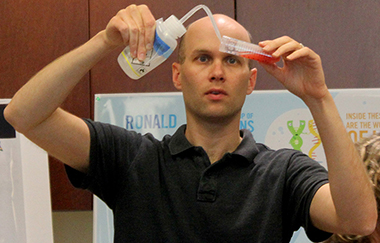Researchers’ recent observations of a stellar-mass black hole called Cygnus X-1 reveal new details about the configuration of extremely hot matter in the region immediately surrounding the black hole. Matter is heated to millions of degrees as it is pulled toward a black hole. This hot matter glows in X-rays. Researchers are using measurements of the polarization of these X-rays to test and refine models that describe how black holes swallow matter, becoming some of the most luminous sources of light — including X-rays — in the universe.
Tag: Corona

Experts from 2020’s happiest country available to comment on this year’s World Happiness Report
In anticipation of this year’s World Happiness Report launch, Aalto University has experts available to comment on Finland’s ranking and factors that make the country and its capital stand out, particularly during this difficult year. Finland led the rankings of…

Rutgers University’s Resilient, Innovative Year Confronting COVID-19
The last year, which has been unlike any other in Rutgers’ 254-year history, has centered on keeping the Rutgers community safe, providing top-notch health care, developing the first saliva test for the coronavirus and helping society cope with the biggest global public health crisis since the 1918 influenza pandemic.
Dilated Blood Vessels in the Lung May Explain Low Oxygen Levels in Severe Cases of COVID-19
A new pilot study from the Icahn School of Medicine at Mount Sinai suggests that COVID-19 is causing significant dilation of the blood vessels of the lung, specifically the capillaries.
FREE McLean Hospital Webinar Series: Unlocking Inner Peace During Turbulent Times – Exploring Spirituality and Mental Health
Dr. David H. Rosmarin Explores Spirituality and Mental Health June 11 @ 12pm, EST During turbulent times, many people turn to spirituality to find inner peace and calm amidst chaos. Spirituality is not limited to religion alone, since it can…

University of Miami Coronavirus Study Targets Possible Sexual Transmission
Men who tested positive for COVID-19 are now being enrolled in a unique study led by the University of Miami Miller School of Medicine to determine the interaction of the virus with semen.

RNA Scientist Receives NSF Funding for Rapid Coronavirus Testing
A biomedical engineer is leading new research that could soon deliver coronavirus test results much faster and at much lower cost.
McLean Hospital: How to Help Kids and Families Keep a Healthy Mindset During the Coronavirus Crisis
With the spread of the coronavirus, families face trying times. More and more information about the crisis comes every day, but the information isn’t always complete or even accurate. Confusion and anxiety plagues everyone—adults and kids. It’s hard to be…

Kids, playgrounds, toys and sports equipment — why it is not safe during a pandemic
UAB expert Samisksha Raut, Ph.D., explains the importance of keeping kids away from playgrounds and from touching various toys and sports equipment during the COVID-19 pandemic quarantine.

UNC Researchers Look to Next Generation Genetic Sequencing for Deeper Understanding of COVID-19
Next generation genetic sequencing – or next generation sequencing (NGS) – is becoming more common in research, although it still isn’t widely available. At the UNC School of Medicine, it is part of a research collaboration to better understand viral lung infections, including COVID-19 – the novel coronavirus sweeping the world.

Leading chloroquine scientists weigh in on drug as possible COVID-19 treatment
“Two independent sources with the same scientific finding make you think it’s true,” says Jean Mulcahy-Levy, MD, investigator at CU Cancer Center and associate professor in the CU School of Medicine Department of Pediatrics.
McLean Mental Health Experts Offer 5 Ways to Reduce Anxiety During the COVID-19 Outbreak
Worrying about catching an infectious disease, the coronavirus or otherwise, while taking care of your family, can be a stressful time. Nathaniel Van Kirk, PhD, Kathryn D. Boger, PhD, ABPP, and Marni J. Chanoff, MD, from McLean, shared ways to keep you…
UNH Researchers Find Clues to How Hazardous Space Radiation Begins
University of New Hampshire researchers use data from NASA’s Parker Solar Probe to observe sun’s plasma and energy build up particles released by solar flares – highlight new phase of energizing process leading to radiation hazards.